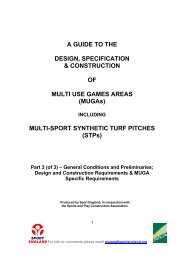View - North East Lincolnshire Council
View - North East Lincolnshire Council
View - North East Lincolnshire Council
Create successful ePaper yourself
Turn your PDF publications into a flip-book with our unique Google optimized e-Paper software.
BOC Immingham Dissolved Acetylene Project Environmental Statement: Vol. 2 Main Text<br />
8.57 Clean rainwater that collects in the bunds will drain to the Drainage System. Any spills will collect<br />
in the bund until they can be removed and disposed of offsite.<br />
Potential Operational Impacts<br />
8.58 The operation of the acetylene facility will be closely monitored and managed by means of an EP<br />
and an ISO 14001 accredited EMS. The following are identified as activities that could potentially<br />
result in deterioration in water quality of the receptor water bodies during the operation phase:<br />
� increasing potential for contaminates, including hydrocarbons, to reach receptor waterbodies:<br />
- inappropriate materials handling, transfer and storage (e.g. accidental spillages) may<br />
cause release of contaminates to the Middle Drain with subsequent release to the<br />
Humber Estuary. BAT and the EIGA Code of Practice for acetylene 15 will be followed with<br />
regards to the storage of all chemicals, wastes and products.<br />
� use and maintenance of plant equipment:<br />
- the use and maintenance of lifting equipment and vehicles could result in fuel leaks etc.<br />
Depending on the volume, location and nature of the release, contaminants could reach<br />
Middle Drain and bind to sediment or be discharged to the Estuary (as described above).<br />
� aqueous discharges (clean surface water runoff, treated domestic effluent, water from<br />
regenerating the water softener, clean water from regenerating the dryers and clean water<br />
from the OWS for the gas and air compressors) to Middle Drain;<br />
- Discharges into Middle Drain and subsequent flow into the Humber Estuary could<br />
theoretically cause deterioration in water quality of these water bodies. However, the<br />
discharges will be essentially clean water and will require consent from the EA and or<br />
NELDB. These discharges would have to have negligible impact in order to be<br />
consented.<br />
� increased area of hardstanding:<br />
- the development will introduce an area of 1.5 ha of hard standing, which will potentially<br />
cause increased surface water runoff and higher sedimentation rates higher suspended<br />
solids load in the receptor water bodies. The drainage network will incorporate catch pits<br />
to capture silt from surface water runoff prior to discharge.<br />
� delivery of higher loads of fine sediment:<br />
- increased traffic on site could result in the generation and deposition of windblown dust<br />
and or water containing elevated levels of sediment. If these sources were to reach<br />
Middle Drain, the increased sedimentation would lead to a higher suspended solids load<br />
in the Middle Drain (and subsequently the Humber Estuary), which could eventually<br />
cause silting, restrict flow and cause damaging effects (smothering) to aquatic<br />
organisms. The drainage network will incorporate catch pits to capture silt from surface<br />
water runoff prior to discharge.<br />
Impact Assessment<br />
8.59 This impact assessment is undertaken using the baseline descriptions of the two receptors, and<br />
the duration and permanence of the impact. The impact assessment is presented in Table 8.6 for<br />
the construction phase and Table 8.7 for the operational phase. The assessment takes into<br />
consideration the high dilution capacity of the Humber Estuary which would reduce the impact of<br />
any pollutants entering the watercourse.<br />
5100935.404 Environmental Statement August 2011 123




